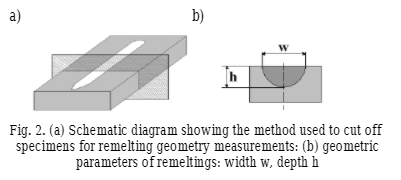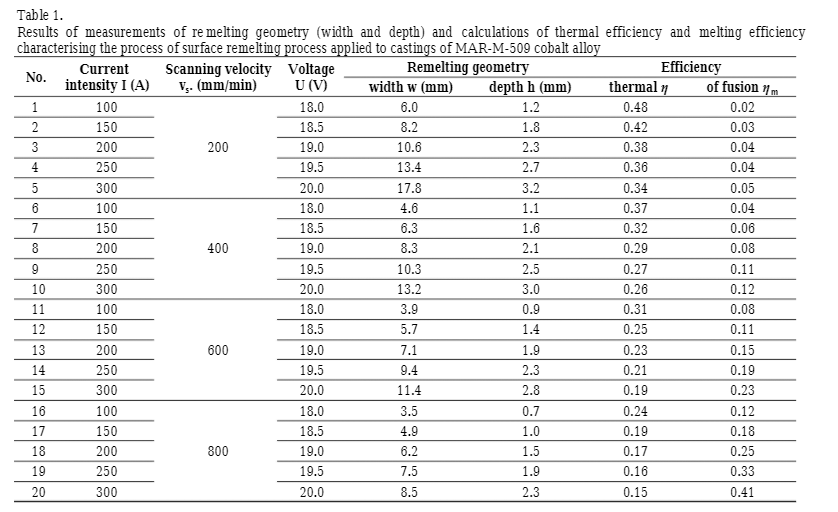Geometry of remeltings
Geometry of the obtained surface remeltings was examined on a cross-section perpendicular to the longitudinal axis of remeltings (Fig. 1). Specimens were cut on the metallographic cut-off machine Labotom 3 of Struers brand using Supra TRD 15 cut-off wheel at the linear velocity of the wheel edge displacement of 37.2 m/s. The wheel was advanced with velocity of about 10 mm/min, at several intervals. In the course of cutting-off the specimens, the wheel was intensively cooled with water. Specimen surfaces selected for observations were prepared with abrasive papers with grit size grades of 150, 500, and finally 1000 at the polishing pad rotational velocity of 150 rpm. In the course of specimen preparation, abrasive papers were wetted with a water stream.

Measurements of geometrical parameters characterising
the remeltings were carried out by means NEOPHOT 2 optical microscope equipped with VIDEOTRONIC CC20P video camera, with the use of advanced image capture and analysis system Multiscan v. 08. Width w and depth h of remelted areas were measured. The adopted method allowed to read out values of the parameters w and h with accuracy of 0.01 mm.
Results or measurements of remelting geometry (width and depth) and calculated values of the heat efficiency and the melting efficiency are presented in Table 1.
3. Conclusions
Based on the obtained test results it was found that with increasing electric current intensity and decreasing electric arc scanning velocity, both width and depth of surface remeltings increase. The largest width w = 17.8 mm and depth h = 3.2 mm was obtained at the electric current intensity I = 300 A and scanning velocity vS = 200 mm/min. The smallest width w = 3.5 mm and depth h = 0.7 mm of remelting was obtained for the electric current intensity I = 100 A and scanning velocity vS = 800 mm/min.

In the adopted range of the GTAW process parameters, the remelting width is more sensitive to the current intensity changes than to variation of the electric arc scanning velocity. Any change in technological parameters characterising the surface remelting technique applied to MAR-M509 alloy castings results in significant differences in thermal efficiency and melting efficiency of the process. Higher current intensities and lower electric arc scanning velocities result in increased amount of heat generated in the electric arc. Accordingly, the amount of heat absorbed by the warmed-up casting also increases. The rate of increase of the heat amount intercepted by the casting related to increase of the current intensity is lower than the respective rate of increase of heat generated in electric arc. The effect is a reduction of the thermal efficiency. The increase of the current intensity and the electric arc scanning velocity results in increased melting efficiency. Higher current intensity means higher energy of the electric energy, and higher scanning speed shortens duration of the remelting process and therefore thermal losses related to heating the specimen up to temperature just below the melting temperature are less.
The obtained results allowed to determine relationships between the thermal efficiency, melting efficiency, and geometrical parameters of remeltings on one hand and technological parameters of the remelting process on the other. The relationship between the thermal efficiency on one hand and the current intensity and the electric arc scanning speed on the other is described by formula:
η = 0.0006·I – 0.0004·vs + 0.57 (3)
Statistical parameters of the equation: R = 0.98; R2 = 0.96;
F = 242.1; Δη = 0.018; α = 0.05.
The relationship between the melting efficiency on one hand and the current intensity and the electric arc scanning speed on the other is described by formula:
ηm = 0.0007·I + 0.0004·vs – 0.19 (4)
Statistical parameters of the equation: R = 0.92; R2 = 0.86;
F = 53.5; Δηm = 0.041; α = 0.05.
The relationship between the remelting width on one hand and the current intensity and the electric arc scanning speed on the other is described by formula:
w = 0.04·I – 0.008·vs + 4.28 (5)
Statistical parameters of the equation: R = 0.96; R2 = 0.92;
F = 103.1; Δw = 1.05 mm; α = 0.05.
The relationship between the remelting depth on one hand and the current intensity and the electric arc scanning speed on the other is described by formula:
h = 0.009·I – 0.0013·vs +0.69 (6)
Statistical parameters of the equation: R = 0.99; R2 = 0.98;
F = 730.4; Δh = 0.08; α = 0.05.
The obtained formulas, characterised with high values of statistic coefficients, can be used effectively in industrial practice for assessment of thermal efficiency and efficiency of fusion in the surface remelting process applied to castings of MAR-M509 alloy and geometry of the obtained remelting patterns based on technological parameters of the surface remelting process carried out by means of the GTAW method.

